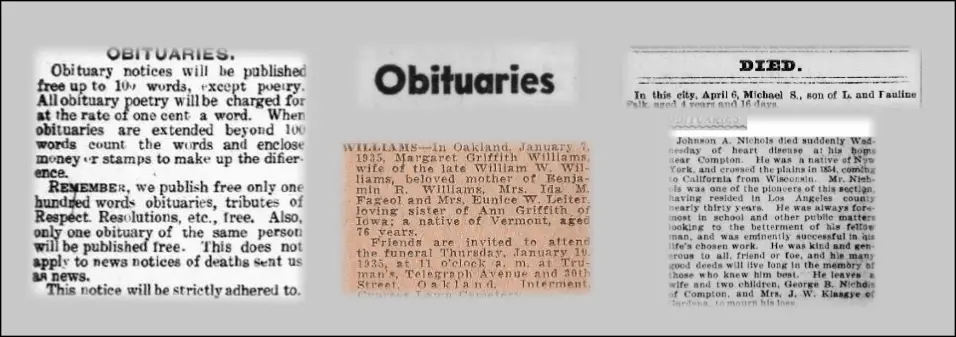
“An obituary is a compact life story of the deceased;
it is likely the only life story of the subject person
ever to be written.”
·
Make the most of what is written in an obituary; look for the information below; and by all means, analyze each and every word carefully.
Death Date – Based on the publication date of the newspaper, sometimes the exact date is listed or the day of the week so you can calculate the date of death.
Death Location – this is not always entered in an obit, but generally it is.
Names of Siblings – especially helpful if the deceased is a married woman with brothers. See next item
Maiden Name – May not be written if the deceased is a married woman. But if the obit names her brothers, their surname may be the surname of the deceased woman at birth
Nativity – maybe this does not identify the exact place of birth – but at least where the deceased immigrated from.
Age – this is usually a part of an obit – even though it should never be construed as an exact age, even in years.
Religion – generally indicated by which church/temple is handling the funeral service.
Death Information of Others – “…brother of the “late” so and so. Indicates that that person is deceased also.
Cause of Death
Birth Location – be careful with these; although they typically state the actual location, “native of ” should not be construed as the actual birth location.
Birth Date
Residences – generally state the most recent city of residence. Helpful for finding someone in a prior census or city directory. In older obits you may find the language: “Philadelphia and Baltimore papers, please copy.” This provides clues as to the deceased’s prior residences.
Names and Residences of Children and Grandchildren – this is especially helpful when census records are not available. Where else are you going to find children’s names?
Marriage “History” Hints – Notice a reference to “step-children. That may imply that the deceased had been married before. Helps to clarify whose children were whose.
Names of Childrens’ and Grandchildrens’ Spouses – this is a fairly recent phenomenon in obituaries, where the name of the spouse of the children/grandchildren is entered. This can help for further cousin finding.
Name of Spouse
Occupation
Membership in Lodges, Associations and Clubs
Hobbies
Burial Information – name of cemetery is likely included. None of course, if cremated. Notice a Neptune Society reference which implies that her ashes may have been “buried” at sea.
Interment Information – name of cemetery. Please note that the name of the cemetery in the obit may be different from where the deceased is actually buried. The burial location could have been changed at the last minute. Or the remains may have been moved to another cemetery at a later date.
Mortuary – this is useful because mortuary records often have much more information than what is written in the obit. So a researcher can contact the mortuary for additional records.
Military Service – might be stated, especially if they served in a war. Notice if a flag is on the obit. That denotes a veteran.
Church Membership – terrific information if one wants to contact the church for additional information
Parents’ and Grandparents’ Names
Schools Attended
College Degrees and Professional Certifications
Government Service – a specialized piece of occupational information that may provide clues for additional research
Sports – what the deceased participated in and who they rooted for
Picture of the Deceased
Unions – did they belong to a union? If so, maybe union records can become an additional set of records to search for additional info.
Awards – whether occupational or otherwise, adds depth to the deceased’s life story.
Other Important Life Events